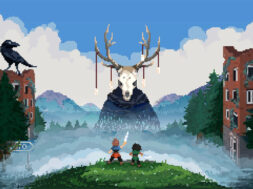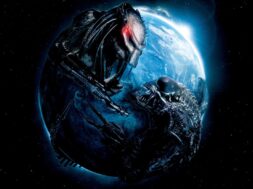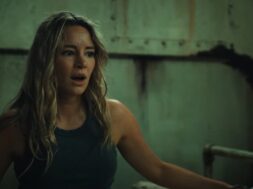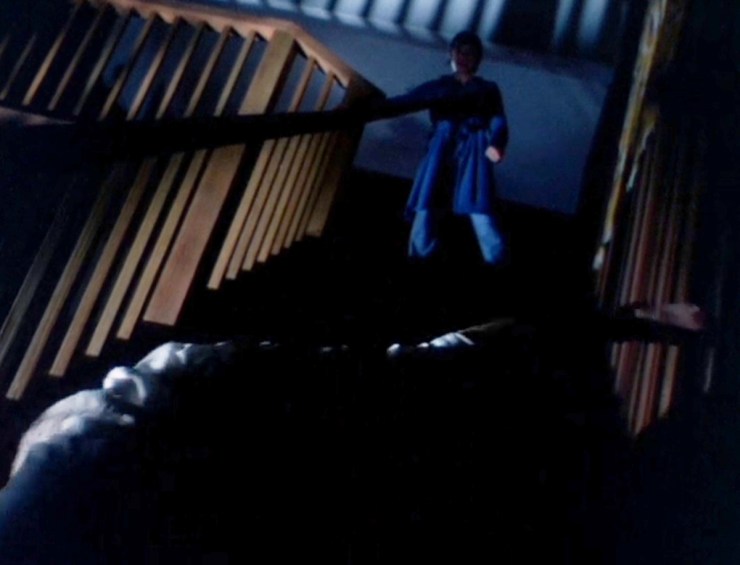The horror anthology movie is unpredictable by nature. These films are made or broken by their own designs; story quality, sequence, and consistency are key criteria. The few examples that excel in all these areas are the paragons of segmented horror.
Although it’s true some of these movies fare better than others in the matter of overall quality, some lesser known anthologies clearly have a standout story that shouldn’t be missed.
The House of the Dead (1978) — “Miss Sibiler”
This omnibus goes by several names: Alien Zone, Five Faces of Terror, and Last Stop on 13th Street. Regardless of the title, The House of the Dead is a curio among regional horrors. This attempt at an Amicus-style anthology was shot in Oklahoma with only a budget of $685,000; director and producer Sharron Miller made her feature debut here. David O’Malley’s script offers up five undercooked stories, but they are all memorable in their own right.
Following the wraparound where a mortician greets his late-night visitor, we meet a school teacher who hates children. Miss Sibiler’s animosity transforms into palpable fear, though, when a pack of kids in ghastly masks shows up at her house one fateful night. There’s no rhyme or reason to the feral tykes’ sudden appearance, yet it’s a classic case of getting one’s comeuppance.
Terror Tract (2000) — “Come to Granny”
Ardent viewers of USA Network may remember seeing this anthology during Shriek Week, a block of horror programming that aired around Halloween. Fans of Cherry Falls will have spotted the movie on a two-for-one DVD. However, this dark comedy has slipped through the cracks and isn’t easy to come by. John Ritter plays a desperate real estate agent hoping to make a sale, or else more than his job will be at stake. Unfortunately, he’s done in by his own misguided strategy of showing his clients murder houses.
In the case of the final story “Come to Granny,” no one was technically killed in the Goodwins’ home. Still, the owners have since moved on because of a local spate of deaths that involved their son. This suburban slasher was likely inspired by Eyes of Laura Mars seeing as the teen protagonist shares an unexplained psychic link with a serial killer nicknamed the Granny Killer. All in all, Terror Tract is an entertaining look at disturbia.
From a Whisper to a Scream (1987) — “Stanley”
Also known as The Offspring, From a Whisper to a Scream boasts a distinguished cast that includes Vincent Price, Susan Tyrrell, and Cameron Mitchell. The movie’s Southern Gothic atmosphere is writ large, and every story takes place at a specific point in Tennessee’s history. Tyrrell plays a reporter who visits Price’s character, a historian recounting macabre tales of the Deep South.
The opening story sees its namesake committing terrible acts. Ultimately, Stanley’s misdeeds come back to bite him in the most literal way possible.
Dead of Night (1977) — “Bobby”
Dan Curtis, the mastermind behind Dark Shadows, followed up on his popular telefilm Trilogy of Terror with another anthology. And like before, famed genre author and screenwriter Richard Matheson was involved. His story “Bobby” was written especially for Dead of Night, and it is easily the most haunting entry here. After a grieving mother uses dark magic to summon her missing son, the truth surrounding the boy’s disappearance and sudden return comes to light. Curtis later remade the same story in Trilogy of Terror II.
Mania (1986) — “The Intruder”
Presented with no enveloping story or even an ersatz host, Canadian anthology Mania is essentially a series of episodes strung together with no glaring theme. Still, the people behind the movie — Paul Lynch (Prom Night), David M. Robertson (Friday the 13th Part V: A New Beginning), John Sheppard (American Nightmare), Peter R. Simpson (Curtains) — will spark some curiosity.
In what is essentially the best of the bunch, “The Intruder” studies a husband’s pathological fear of dogs when his wife convinces him to adopt a Rottweiler. He is constantly ill at ease around his new pet, but he’ll ultimately have wished he had paid more attention to the dog’s incessant barking. Robertson’s contribution is a sharp interpretation of a classic urban legend we don’t hear enough of nowadays.
Horror Stories 2 (2013) — “The Escape”
The South Korean anthology series Horror Stories is generally replete with high-grade scares and suspense — “Ambulance on the Death Zone” in the first film should not be missed — but its meager second installment survives only because of “The Escape.” The first and third movies in this franchise are commercially available in the West, whereas Horror Stories 2 is more elusive.
The sequel’s setup sees a pair of life insurance agents reviewing three unusual cases one night. Topping things off, they look at a trainee teacher’s peculiar demise in Jung Bum-sik’s “The Escape.” This epic entry about a man being trapped in a hellish dimension suffuses humor without skirting thrills.
All the Creatures Were Stirring (2018) — “Dash Away All”
Christmas horror entices us for several reasons. Namely, it zeroes in on the unspoken loneliness of holidays all the while creating terror at a time when people are expected to be joyous. Rebekah and David Ian McKendry follow tradition by underlining the potential ghoulish side of Yuletide activities. One of their film’s highlights, “Dash Away All” centers around a father and husband whose last-minute Christmas shopping lands him in a life-or-death situation.
The story’s mythos is intriguing, and the main character is sympathetic. Out of all the segments here, “Dash Away All” could have worked as a longer feature.
Amusement (2008) — “Tabitha”
With its magazine-ready cast and high production values, it seems obvious the soft anthology Amusement was meant for the big screen. On the contrary, the studio yanked this one from the release schedule and sent it straight to video with very little afterthought.
The overall story is hardly sound and falls apart if you really think about it. What does work, however, are the individual stories. They’re essentially protracted set pieces where the main characters are separately abducted by a serial killer known only as The Laugh. The most singular tale, “Tabitha” sees a babysitter turning paranoid when she finds a life-sized clown doll in the house.
Screamtime (1983) — “Dreamhouse”
Originally a short coupled with longer films in theaters, Michael Armstrong’s “Dreamhouse” was later added to his and Stanley A. Long’s anthology Screamtime. The British movie begins with two Americans stealing a handful of VHS tapes from a shop. Little do they know, the scary movies they watch aren’t entirely fictional.
“Charming” is the best way to describe Screamtime, a no-budget medley of kooky stories. It’s not high-brow or even competently made, yet there’s some fun to be had here. The aforementioned “Dreamhouse” alone makes the movie worth watching at least once. In it, a woman believes her family’s new home is haunted by ghosts that only she can see; the truth is far more terrifying. The story was later turned into a longer feature in 2010 called Psychosis.
Fear(s) of the Dark (2007) — Mattotti’s Story
The French animated anthology Fear(s) of the Dark is a buffet of art and imagination; no two stories or styles are alike. The only thing these overlapping vignettes have in common is their lack of color. The movie included the talents of artists Blutch, Charles Burns, Marie Caillou, Pierre di Sciullo, Lorenzo Mattotti, and Richard McGuire.
This segment is remarkable and eldritch thanks to Mattotti’s prowess as an illustrator. He achieves a truly ambient anecdote about a man remembering his time in pastoral France: a village is besieged by an unseen predator that stalks the foggy marshes. The vague ending stirs up memories of classic children’s ghost stories. Mattotti, who is known for his renowned color work and enigmatic designs, draws us in with breathing scenery and imaged disquietude.
Nightmares (1983) — “Terror in Topanga”
The four stories presented here were intended to be part of an unnamed pilot for NBC before they became Nightmares. There is no host, and the only connective tissue is an overarching theme of obsession. As dated as these stories look, they are equally freaky. Be it Lance Henriksen battling a demonic pickup truck, or a family under attack by a giant rat, this compilation is full of creepy, cautionary tales.
“Terror in Topanga” is a straightforward yet tense opener that plays on basic fears. It’s firmly rooted in contemporary folklore, but that doesn’t make the conclusion any less effective.
Chilling Visions: 5 Senses of Fear (2013) — “Listen”
This anthology first aired on the now-defunct Chiller network, and just as the title suggests, every independent segment is based on one of the five human senses. Not every tale is as engaging as the next so one’s mileage may vary. Jesse Holland and Andy Mitton’s “Listen” documents a supposedly cursed song that kills anyone who listens to it. This closing story outweighs its peers mainly because of its urgency and mystique; the found-footage structure also adds another layer.
The Centerfold Girls: (1974) — The Second Story
John Peyser’s The Centerfold Girls is another soft anthology where multiple women are individually preyed upon by a male killer; the villain selects his targets from a men’s magazine.
Every section of this exploitative movie has the victims imperiled directly by either the main threat or some other sadistic party beforehand. The first section demonstrates the risk of picking up hitchhikers, and the final act shows the antagonist finally meeting his match in the form of Tiffany Bolling. Sandwiched in between is a story that feels the most atmospheric: models are picked off during a photo shoot at a remote island mansion. The Centerfold Girls encapsulates the good and bad characteristics of this era of proto-slashers.
Tales of the Third Dimension (1984) — “Visions of Sugar Plum”
Lackluster stories are a detriment to good anthologies. A rule of thumb, however, is remembering that for every few so-so segments, a movie should have an entry that will restore faith in the viewer. This is what happened with Tales of the Third Dimension, a direct-to-video omnibus hosted by an animatronic and droll skeleton named Igor. After two piddling stories, the movie ends on a high note.
“Visions of Sugar Plum” sees two kids spending Christmas with their grandmother. When the elderly woman runs out of her medication, she becomes agitated and paranoid. Now, her grandchildren fear for their lives as Grandma chases after them with a gun and an electric hedge trimmer. If that doesn’t sound funny enough, stay tuned for the ending’s deux ex machina.
The Dark Tapes (2016) — “The Hunters and the Hunted”
Using a found-footage format helps The Dark Tapes stand out even though the idea itself wasn’t novel at this point. The most successful use was in “The Hunter and the Hunted,” a deceitful story about a couple moving into a new house. When they suspect they’re being haunted, they reach out to paranormal investigators. It sounds routine, but writer Michael McQuown has a surprise in store for audiences.
Screams of a Winter Night (1979) — “The Moss Point Man”
Before its astonishing restoration by Code Red, Screams of a Winter Night was all but lost. The only copies available until then were low-grade. Thankfully, enthusiasts of regional horror can now see this Dimension Pictures anthology in its full form — a removed story was added back in.
James L. Wilson’s Louisiana-shot film makes the interesting choice of spending a sizable amount of time with the wraparound’s characters. One of whom is John, who shares his own interpretation of the classic “Boyfriend’s Death” legend that was still popular around this time period. The same myth is notably retold in 1997’s Campfire Tales.
After Midnight (1989) — “All Night Operator”
Ken and Jim Wheat’s After Midnight has developed a small but faithful following after all these years. With its surreal wraparound and a sprinkling of familiar faces, this MGM anthology is one of the eighties’ best kept secrets.
All three segments are told during an after-hours session at a psychology professor’s house. The students’ most persuasive yarn — built on the theme of fear, as is the course’s objective — is “All Night Operator,” a cat-and-mouse thriller. Marg Helgenberger works the graveyard shift all alone at a phone messaging service when she’s targeted by one of her client’s deranged stalkers.
Tales of the Unusual (2000) — “One Snowy Night”
Based on the long-running television franchise of the same name, Tales of the Unusual is the Japanese equivalent of the Twilight Zone. It’s not always horror — as a matter of fact, only one story in the 2000 movie is explicitly horror.
A rainy night leaves train commuters stranded in a virtually empty station. To busy themselves until the weather lets up, they listen to a mysterious man wearing sunglasses. His disconcerting demeanor is overlooked in favor of some entertaining stories; one of which includes the unnerving “One Snowy Night.” After their plane crashes in the mountains, survivors seek shelter in a nearby shack. They take turns sleeping before realizing they may not be the only ones inside the cabin. This startling revelation is achieved through the clever use of a handheld video camera.
The Uncanny (1977) — “London 1912”
Peter Cushing plays an ailurophobic writer who tries to convince his publisher that cats are evil creatures. His first example is set in 1912; a man discovers his wealthy aunt is leaving her fortune to her pets rather than him. The nephew then sends his lover, also his aunt’s maid, to destroy the original will. Her doing so finally incurs the wrath of the old woman’s many cats.
The Uncanny is sometimes mistaken for an Amicus production, but it’s really produced by The Rank Organisation. Even so, the similarities are hard to miss in this neglected anthology.
Phobia 2 (2009) — “Backpackers”
The success of Thai anthology 4bia (Phobia) led to a sequel that is mostly better than the first. The last story has its issues, but the four before it are a good set.
“The Backpackers” is a harrowing account of two Japanese tourists being at the wrong place at the wrong time. After they convince a shady truck driver to give them a lift, they discover his haul is nothing but corpses. That’s only the beginning of this wretched ride from hell.
Future Shock (1994) — “The Roommate”
The late Bill Paxton appeared in this early-nineties anthology that produced a tie-in comic. His story “The Roommate” is a role reversal for the actor — in 1992’s The Vagrant, Paxton was on the other end of a bad housing situation. Instead of being the hapless property owner, he’s now the obnoxious freeloader. Even though his and the main character’s encounters are overtly humorous and never scary, the segment is a small delight. Another of the film’s directors, Matt Reeves, would later direct Cloverfield and Let Me In.
Fantastic Theater (2011) — “The Loneliness of Butcher Boy”
The biggest peril of hyperlink cinema is organically connecting everything. Self-contained stories in any given anthology is comparatively easy, whereas a movie like Fantastic Theater has to tread carefully. What’s even more difficult is having multiple directors in charge — there’s always the risk of clashing styles and voices. The three directors in this South Korean film, on the other hand, do a commendable job of keeping everything coherent from a narrative standpoint.
Fantastic Theater (also known as Short! Short! Short!) artfully visualizes the struggle between reality and fantasy; the strive for creativity in a world dictated by money is also on display. The most accessible story in this arthouse anthology about movies within movies is the middle portion: a teenage vegetarian crosses paths with a killer Minotaur. It doesn’t all make sense, but the film’s cinematic eye candy is worthwhile.
The Field Guide to Evil (2018) — “Haunted by Al Karisi, The Childbirth Djinn”
On top of challenging subject matter and experimental filming techniques, several horror anthologies born in the last decade have been positively ambitious. There is also more diversity and crossover appeal than ever before.
By pooling the talent of eight unique directors, The Field Guide to Evil unveils a wide range of folkloric stories. Baskin director Can Evrenol stops viewers in their tracks with “Haunted by Al Karisi, The Childbirth Djinn.” This allegorical story examines women’s domestic roles with frightening results.
Chilling Visions: 5 States of Fear (2014) — “Mutilation”
In the unrelated sequel to Chilling Visions: 5 Senses of Fear, terror hits the road and travels to five different states. Amid this party of five is the very nasty “Mutilation,” a story entailing a man seeking to scatter his late father’s ashes at a campsite. He and his partner soon succumb to hallucinations where they think insects are buried beneath their skin. Inspirations for “Mutilation” are likely “The Raft” from Creepshow 2 and Bug.
Family Portraits: A Trilogy of America (2003) — “Cutting Moments”
Filmed around the mid-nineties, the segments in this sometimes graphic drama vary from lethargic to utterly shocking. Director Douglas Buck does not bother with formalities as he delves straight into the incredibly grotesque and disturbing “Cutting Moments.” A housewife is torn between her maternal obligations and her own desires within a failing marriage. Her husband’s mind is elsewhere and the matriarch will do whatever it takes to finally seize his attention. Here, the appetizer winds up being better than the actual meal.
The Willies: (1990) — “Bad Apples”
This juvenile anthology often looks and acts like a spiritual extension of Are You Afraid of the Dark? albeit more bloody and scuzzy. The narrative format is unconventional, but the longer segments are agreeable. “Bad Apples” is a wonderful update of “The Boy Who Cried Wolf” except the wolf is a monster who lives in the school restroom. The more Danny swears the creature exists, the more his acerbic teacher refuses to believe him. That is, until it’s too late to change her mind.
Chillers: (1987) — Mason’s Story
Daniel Boyd’s debut feature Chillers is as earnest as it is cheesy. The actual content isn’t all that exciting, but there is the occasional bright spot in this West Virginia-shot anthology. In the same vein as 1973’s The Vault of Horror, the main characters pass the time at a bus station by sharing their portentous dreams. Young Mason, who is on his way to a scout camp, describes his recent nightmare — he and several other boys are menaced by a bloodthirsty madman while out in the woods. This story utilizes its environment the best, and there is some genuine tension.
Deadtime Stories: (1986) — “Little Red Runninghood”
Deadtime Stories‘ wraparound has an impatient uncle telling his scared nephew morbid fairy tales before bedtime. To no one’s surprise but his own, Uncle Mike’s counterintuitive decision only exacerbates the boy’s fear, and he spends the night entertaining Peter with more horrid fables. One of which is an amusing spoof of “Little Red Riding Hood;” a teen decked in red ends up with the wrong bag when picking up her grandmother’s medication at the pharmacy. Unfortunately, the prescription she takes home is for a werewolf, and he’s decided to pay Granny a visit.
The Illustrated Man: (1969) — “The Veldt”
Ray Bradbury’s book of the same name is the basis for this divisive adaptation. The movie wound up being a critical and financial flop, and the author himself was not a fan. Be that as it may, the film has artistic merit in addition to intense performances. The Illustrated Man plays out like The Canterbury Tales; the stories within accentuate rather than detract from the main one. The suggestive chemistry between Rod Steiger and Robert Drivas’ characters is another draw.
Between “The Veldt” and “The Long Rain,” the former feels the most complete. A family of the future is in trouble because the children are consumed with their virtual reality nursery. When the parents threaten to take it away, their progeny retaliate. There is no denying the white interiors, décor, and general aesthetic were inspired by that of 2001: A Space Odyssey.
The Curse of Kazuo Umezu: (1990) — “The Haunted Mansion”
One of Junji Itō’s biggest influences is esteemed manga author Kazuo Umezu. Known for his detailed and macabre illustrations, Umezu is also adept at emphasizing raw human emotions in the presence of horror. His ability to capture freeze frames of intense inwardness — those deep, heightened feelings that surface upon seeing something so unspeakable — is nothing short of brilliant.
The Curse of Kazuo Umezu is a straight-to-video anthology featuring two standalone stories. Although each one is positively crude-looking by today’s standards, the artwork has a lot of character to it. “What Will the Video Camera Reveal” includes a vampiric, tentacle-faced demon, and “The Haunted Mansion” has four girls exploring a sinister old house. Neither short will disappoint fans of anime horror, but the timeless appeal of the second tale is hard to resist.







































